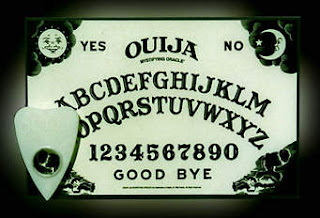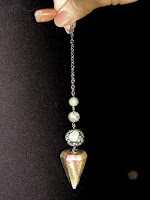Ideomotor Reflex
Ideomotor Reflex
I am writing about the ideomotor reflex effect because I believe that it is relevant to paranormal investigating and to maintaining a valid and authentic scientific approach. In the recent past, paranormal investigating liked to claim, whether sincerely or not, that the methods used are scientific and unbiased. But, more recently, the paranormal investigator has allowed methods and tools that are in no way scientific to creep into their arsenal of tools. Such things as Ouiji Boards, pendulums, and dowsing rods, are now utilized routinely in many groups as tools, along with cameras, EMF meters, and voice recorders, to do investigations into paranormal activity. These traditional objects come from a long history of use in occult practices. Mediums of the 1840's -1880's utilized such devices to communicate with "the dead" or spirit. The problem with these devices is a person must be in control of them. These objects only require a very minute movement to work. Hence, the ideomotor reflex.
The ideomotor reflex is defined as a psychological phenomenon where a person makes unconscious motions. It's a concept first put forth by hypnotists and psychologists. Ideo refers to an idea or mental representation and motor refers to muscular action or motion. It means that a thought or mental image brings about a seemingly reflexive, unconscious or automatic muscular reaction, often of minuscule degree, and possibly without the person being aware of what they are doing.
This is like a person's reflexive response to pain. The body reacts reflexively or unconciously with an ideomotor reflex to thoughts alone, without the person consciously deciding to take action. Scientists have attributed the effects of automatic writing, dowsing, facilitated communication, and Ouija boards to this phenomenon.
There is something referred to as the ideo-dynamic reflex, which applies to a much wider phenomenon; extended to describe all bodily reaction caused unconsciously by certain ideas. You think you are feeling an itch on your skin and, before you know it, you have itchy skin for real. Just mentioning being itchy makes me scratch. This can also be the principle through which suggestion operates in hypnotism. The power of suggestion can be very compelling.
The mediums of the 1800's used a variety of techniques for communicating with the spirit world. These techniques included use of what we now call the Ouija board, table-turning, pendulums and dowsing rods.
These phenomena and devices soon became the subject of scientific investigation. Scientific tests by Michael Faraday, and others, have demonstrated that many phenomena attributed to spiritual or paranormal forces, or to mysterious energies, are actually due to ideomotor action. These tests demonstrated that honest, intelligent people can unconsciously engage in muscular activity that is consistent with their expectation. They also show that suggestions that can guide behavior can be given subtle cues. This sort of thing is similar to unconsciously executing a routine task, sometimes referred to as procedural memory, and then suddenly realizing you did it when you snap out of your thoughts.
In modern paranormal investigating, these objects have become common and are often seen on paranormal investigation tv shows. The common attitude is that these devices are as useful and accurate as an EMF meter or a voice recorder to detect possible paranormal activity. However, when the human element is added to any device so easily moved with minuscule movements of the hand, such as dowsing rods or pendulums, the ideomotor reflex can very possibly interfere with honest readings or movements of the device. The person controlling the device may honestly have no conscious awareness of moving the device, but may be doing so anyway. Of course, the person may also be faking and consciously moving the device. Since the movements are so very minuscule, it's very hard to catch anyone faking.
So, my point is, perhaps it's a good idea to forgo the use of such occult devices, due to the very real possibility that the ideomotor reflex may be the cause of the movement of a pendulum, the crossing of dowsing rods, or the movement of the planchette on a Ouija board. Perhaps the possibility is too great to risk such a possibility in, what you want to be, a science-based investigation into the paranormal.
I have a theory, not proven, that, maybe, if the investigator using such devices, is hyper aware, and knowledgeable regarding the ideomotor reflex, they may be able to override it and not move the device by their own hand. I don't know. I don't even know how this could be tested. It's just a theory. In the meantime, I choose not to utilize Ouija boards, pendulums or dowsing rods in investigations, and to see such results from the use of such devices questionable and unreliable.
*Information and research for this article are from internet source of wikipedia and my own first hand, personal knowledge.
I am writing about the ideomotor reflex effect because I believe that it is relevant to paranormal investigating and to maintaining a valid and authentic scientific approach. In the recent past, paranormal investigating liked to claim, whether sincerely or not, that the methods used are scientific and unbiased. But, more recently, the paranormal investigator has allowed methods and tools that are in no way scientific to creep into their arsenal of tools. Such things as Ouiji Boards, pendulums, and dowsing rods, are now utilized routinely in many groups as tools, along with cameras, EMF meters, and voice recorders, to do investigations into paranormal activity. These traditional objects come from a long history of use in occult practices. Mediums of the 1840's -1880's utilized such devices to communicate with "the dead" or spirit. The problem with these devices is a person must be in control of them. These objects only require a very minute movement to work. Hence, the ideomotor reflex.
The ideomotor reflex is defined as a psychological phenomenon where a person makes unconscious motions. It's a concept first put forth by hypnotists and psychologists. Ideo refers to an idea or mental representation and motor refers to muscular action or motion. It means that a thought or mental image brings about a seemingly reflexive, unconscious or automatic muscular reaction, often of minuscule degree, and possibly without the person being aware of what they are doing.
This is like a person's reflexive response to pain. The body reacts reflexively or unconciously with an ideomotor reflex to thoughts alone, without the person consciously deciding to take action. Scientists have attributed the effects of automatic writing, dowsing, facilitated communication, and Ouija boards to this phenomenon.
There is something referred to as the ideo-dynamic reflex, which applies to a much wider phenomenon; extended to describe all bodily reaction caused unconsciously by certain ideas. You think you are feeling an itch on your skin and, before you know it, you have itchy skin for real. Just mentioning being itchy makes me scratch. This can also be the principle through which suggestion operates in hypnotism. The power of suggestion can be very compelling.
The mediums of the 1800's used a variety of techniques for communicating with the spirit world. These techniques included use of what we now call the Ouija board, table-turning, pendulums and dowsing rods.
These phenomena and devices soon became the subject of scientific investigation. Scientific tests by Michael Faraday, and others, have demonstrated that many phenomena attributed to spiritual or paranormal forces, or to mysterious energies, are actually due to ideomotor action. These tests demonstrated that honest, intelligent people can unconsciously engage in muscular activity that is consistent with their expectation. They also show that suggestions that can guide behavior can be given subtle cues. This sort of thing is similar to unconsciously executing a routine task, sometimes referred to as procedural memory, and then suddenly realizing you did it when you snap out of your thoughts.
 |
| Ouija board |
 |
| pendulum |
 |
| table tipping |
So, my point is, perhaps it's a good idea to forgo the use of such occult devices, due to the very real possibility that the ideomotor reflex may be the cause of the movement of a pendulum, the crossing of dowsing rods, or the movement of the planchette on a Ouija board. Perhaps the possibility is too great to risk such a possibility in, what you want to be, a science-based investigation into the paranormal.
I have a theory, not proven, that, maybe, if the investigator using such devices, is hyper aware, and knowledgeable regarding the ideomotor reflex, they may be able to override it and not move the device by their own hand. I don't know. I don't even know how this could be tested. It's just a theory. In the meantime, I choose not to utilize Ouija boards, pendulums or dowsing rods in investigations, and to see such results from the use of such devices questionable and unreliable.
*Information and research for this article are from internet source of wikipedia and my own first hand, personal knowledge.

Comments